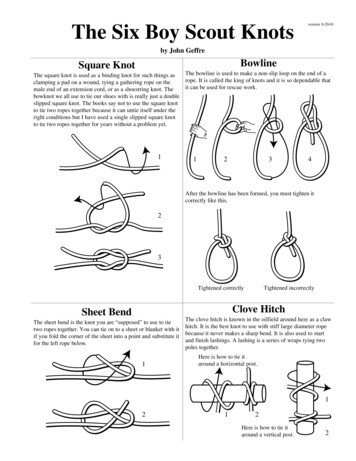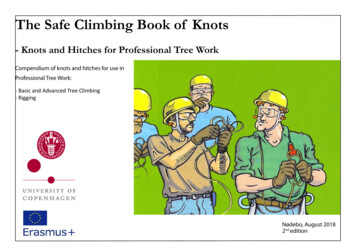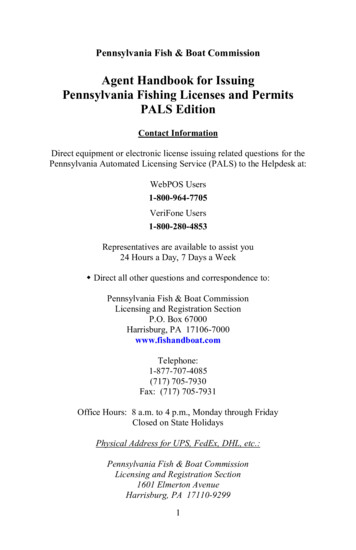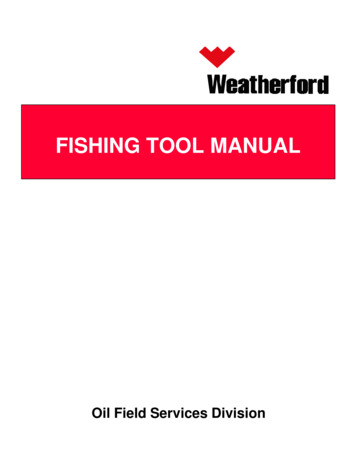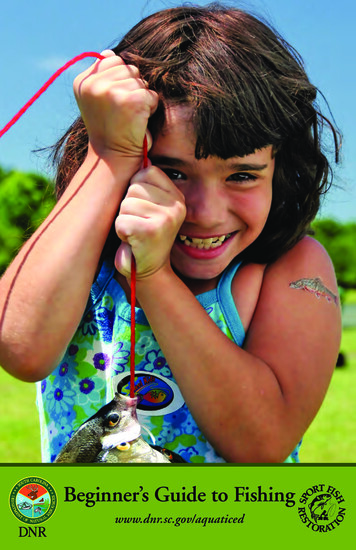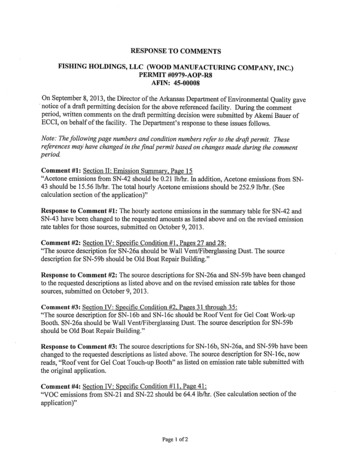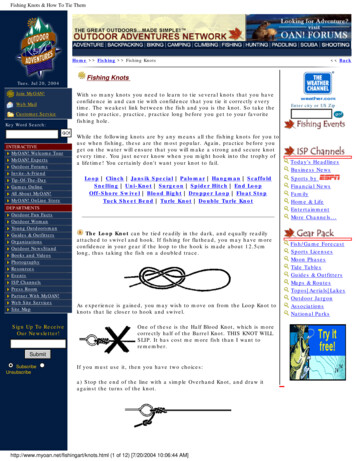
Transcription
Fishing Knots & How To Tie ThemHome Fishing Fishing KnotsTues. Jul 20, 2004Join MyOAN!Web MailCustomer ServiceKey Word Search:INTERACTIVEMyOAN! Welcome TourMyOAN! ExpertsOutdoor ForumsInvite-A-FriendTip-Of-The-DayGames OnlineAll About MyOAN!MyOAN! OnLine StoreFishing KnotsWith so many knots you need to learn to tie several knots that you haveconfidence in and can tie with confidence that you tie it correctly everytime. The weakest link between the fish and you is the knot. So take thetime to practice, practice, practice long before you get to your favoritefishing hole.While the following knots are by any means all the fishing knots for you touse when fishing, these are the most popular. Again, practice before youget on the water will ensure that you will make a strong and secure knotevery time. You just never know when you might hook into the trophy ofa lifetime! You certainly don't want your knot to fail.Loop Clinch Jansik Special Palomar Hangman ScaffoldSnelling Uni-Knot Surgeon Spider Hitch End LoopOff-Shore Swivel Blood Bight Dropper Loop Float StopTuck Sheet Bend Turle Knot Double Turle KnotDEPARTMENTSOutdoor Fun FactsOutdoor WomanYoung OutdoorsmanGuides & OutfittersOrganizationsOutdoor NewsStandBooks and VideosThe Loop Knot can be tied readily in the dark, and equally readilyattached to swivel and hook. If fishing for flathead, you may have moreconfidence in your gear if the loop to the hook is made about 12.5cmlong, thus taking the fish on a doubled trace.PhotographyResourcesEventsISP ChannelsPress RoomPartner With MyOAN!Web Site ServicesSite MapSign Up To ReceiveOur Newsletter!As experience is gained, you may wish to move on from the Loop Knot toknots that lie closer to hook and swivel.One of these is the Half Blood Knot, which is morecorrectly half of the Barrel Knot. THIS KNOT WILLSLIP. It has cost me more fish than I want toremember.SubmitSubscribeUnsubscribe BackIf you must use it, then you have two choices:a) Stop the end of the line with a simple Overhand Knot, and draw itagainst the turns of the knot.http://www.myoan.net/fishingart/knots.html (1 of 12) [7/20/2004 10:06:44 AM]Enter city or US ZipToday's HeadlinesBusiness NewsSports byFinancial NewsFamilyHome & LifeEntertainmentMore Channels.Fish/Game ForecastSports LicensesMoon PhasesTide TablesGuides & OutfittersMaps & RoutesTopos Aerials LakesOutdoor JargonAssociationsNational Parks
Fishing Knots & How To Tie Themb) or make the Half Blood Knot into a Clinch Knot.Top of PageClinch Knot1. Pass the line through theeye of the hook, or swivel.2. Double back. make fiveturns around the line.3. Pass the end of the linethrough the first loop,above the eye, and thenthrough the large loop.Draw the knot into shape.4. Slide the coils down tightagainst the eye.Top of PageJansik SpecialAnother beautifully simple knotthat can be tied in the dark, TheJansik Special is a high strengthknot tied as follows:1. Put 15cm of line throughthe eye of the hook.2. Bring it around in a circle3.4.5.6.and put the end throughagain.Making a second circle,pass then end through athird time.Holding the three circlesof line against each other,wrap the end three timesaround the circles.Either hold the hooksteady with pliers, ormake it fast to boat'srigging or safety lines.Holding strain on the hook, pull on both ends of the line to tighten.Top of PagePalomar Knothttp://www.myoan.net/fishingart/knots.html (2 of 12) [7/20/2004 10:06:44 AM]
Fishing Knots & How To Tie ThemThe Palomar Knot is anothervery simple knot for terminaltackle. It is regarded by theInternational Game FishAssociation consistently as thestrongest knot known. It's greatvirtue is that it can safely be tiedat night with a minimum ofpractice.1. Double about 12.5cm ofline, and pass through theeye.2. Tie a simple OverhandKnot in the doubled line,letting the hook hangloose. Avoide twisting thelines.3. Pull the end of loop down,passing it completely over the hook.4. Pull both ends of the line to draw up the knot.Top of PageHangman's KnotThere are at least 6 variations ofthe Hangman's Knot, - all ofthem excellent for terminaltackle, swivels and hooks. The"standard" Hangman's Knotholds only five turns when tiedin monofilament nylon. If tied inrope, and used for its statedpurpose, it takes eight turns.1. Pass a 15cm loop of linethrough the eye.2. Bring the end back onitself, passing it under thedoubled part.3. Make five loops over thedoubled part.4. The formed knot is worked into shape.5. The knot is sent down the line, against the eye of the hook orswivel.Top of PageScaffold Knothttp://www.myoan.net/fishingart/knots.html (3 of 12) [7/20/2004 10:06:44 AM]
Fishing Knots & How To Tie ThemThis is a much simpler variant.In all likelihood, this Grant's UniKnot. I have used it for morethan fifty years and it has neverfailed me, whether tied in 1kg or50kg monofilament. It wastaught to me by the late WallyKerr, a top flathead fisherman.1. Pass a 15cm loop of linethrough the eye.2. Lock the upper partbetween thumb andforefinger, making a loop.3. Make two more loops overthe double part, holdingthem too, between thumband forefinger.4. Pass the end through thetwo loops just made, plus the first loop made in step2.5. The formed knot can now be drawn into shape, and worked downagainst the eye of the hook or swivel.Top of PageSnelling A HookOne small problem is the variety of names that mey be applied to the oneknot, for examle, a Granny is a False Knot, a Clove Hitch is a Waterman'sKnot, an Overhand Knot is a Thumb Knot. But when we come to snelling ahook, the length of nylon attached to the hook may be a snell or a snood.I now find that the actual job of tying the snood may be called snoozing,while snelling is often jealously thought of as an art restricted to the flyfisherman. I have fished with bottom-fisherman on the Great Barrier Reefwho routinely snell their hooks.Restricted to lines of breakingstrength less than about 20kg,the process is a simple one.1. Pass the end of the line,2.3.4.5.trace or tippet throughthe eye twice, leaving aloop hanging below thehook.Hold both lines along theshank of the hook.Use the loop to wind tightcoils around the shankand both lines, from theeye upwards. Use from 5to 10 turns.Use the fingers to holdthese tight coils in place.Pull the line (extendingfrom the eye) until thewhole loop has passed under these tight coils.With coils drawn up, use pliers to pull up the end of the line.http://www.myoan.net/fishingart/knots.html (4 of 12) [7/20/2004 10:06:44 AM]
Fishing Knots & How To Tie ThemTop of PageBlood Knot - Joing Line To LineThere are two top grade knots used to join one line to another, wherethese are approximately of the same thickness. These are the Blood Knotand the Hangman's Knot - also called the Uni Knot by the InternationalGame Fish Association.Where there diameters are verydissimilar, either the Surgeon'sKnot should be used, or thethinner line should be doubledwhere the knot is formed.1. Lie the ends of the two2.3.4.5.lines against each other,overlapping about 15cm.Take 5 turns around oneline with the end of theother, and bring the endback where it's heldbetween the two lines.Repeat by taking 5 turnsaround the other line,bringing the end backbetween the two lines.These two ends shouldthen project in oppositedirections.Work the knot up intoloops, taking care that thetwo ends do not slip out of position.Draw the knot up tightly.Top of PageUni-Knot Version Of The Hangman's KnotA better join can be made usingone of the Hangman's Knots,known to the International GameFish Association fisherman asthe Uni-Knot.This is a knot used for attachingthe line to the spool of the reel.1. Overlap the two lines forabout 15cm.2. Using one end, form acircle that overlies bothlines.3. Pass the end six timesaround the two lines.4. Pull the end tight to drawthe knot up into shape.5. Repeat the process using the end of the other line.http://www.myoan.net/fishingart/knots.html (5 of 12) [7/20/2004 10:06:44 AM]
Fishing Knots & How To Tie Them6. Pull both lines to slide the two knots together.Top of PageSurgeon's KnotEarlier mention was made that ifthe two lines to be joined varygreatly in their diameters, thelesser line may be doubled atthe knot, or the Surgeon's Knotmay be used. In the latter case,it will probably be necessary tohave one of the lines rolled on aspool, or perhaps wrapped on atemporary card, so that it maybe passed through the loop.1. Lay the two lines against2.3.4.5.each other, overlappingabout 22.5 cm.Working the two lines asone, tie an OverhandKnot. It will be necessary to pull one line (say the leader)completely through this loop.Pull the leader through this loop again.Pass the other end through the loop.The formed knot can now be worked into shape.Top of PageSpider HitchThe offshore fisherman often have a need to tie a double line - a longloop of line that is obviously stronger, and easier to handle, than the lineitself. In accordance with International Game Fish Association Rules, thedouble line may be up to 4.5m long in lines up to 10kg, and as much as9m in heavier lines.http://www.myoan.net/fishingart/knots.html (6 of 12) [7/20/2004 10:06:44 AM]
Fishing Knots & How To Tie ThemThe double may be tied bymeans of the simple Spider Hitchwith lines to 15kg. The big gameboys use the Bimini Twist, adouble that is normally formedby two people who make theintitial twenty twists. The Biminiis obviously beyond the scope ofthis little book. It's smallerbrother, the Spider Hitch, is amuch faster and easier knot forthe light tackle fisherman.1. Form a loop of the desiredlength, say 1.25m.2. Twist a section into asmall loop.3. This is the only tricky part- hold this loop withthumb and forefinger, thethumb extending abovethe finger, and with theloop standing up beyondthe tip of the thumb.4. Wind the doubled line around the thumb and the loop 5 times.5. Send the rest of the long loop through the small loop, and pullgently to unwind the turns off the thumb.6. The knot is now formed and worked into tight coils.Top of PageOffshore Swivel Knothttp://www.myoan.net/fishingart/knots.html (7 of 12) [7/20/2004 10:06:44 AM]
Fishing Knots & How To Tie ThemThis is a special knot used forattaching a swivel to a double line.1. Put the end of the double2.3.4.5.6.line through the eye of theswivel.Rotate the end half a turn,putting a single twistbetween the end of the loopand the swivel eye.Pass the loop with the twistover the swivel. Hold theend of the loop, togetherwith the double, with onehand, and allow the swivelto slide to the end of thedouble loops that haveformed.Continue holding the loopand the lines with the righthand. Use the left hand torotate the swivel throughboth loops 6 times or more.Keep pressure on bothparts of the double line.Release the loop. Pull onthe swivel and loops of linewill start to form.Holding the swivel withpliers, or (better still)attaching it with a shortlength of line to the rigging,push the loop down towardsthe eye while keeping pressure on the double line.Top of PageSurgeons End LoopLoops are made for the purpose of attaching leaders, traces or otherterminal tackle. They have the advantage that they can be tied quicklyand in the dark.The Surgeon's End Loop is aneasy way to go.1. Take the end of the lineand double it to form aloop of the required size.2. Tie an Overhand Knot atthe desired point, leavingthe loop open.3. Bring the doubled linethrough the loop again.4. Hold the line and the endpart together, and pull theloop to form a knot.Top of Pagehttp://www.myoan.net/fishingart/knots.html (8 of 12) [7/20/2004 10:06:44 AM]
Fishing Knots & How To Tie ThemBlood Bight KnotAnother end loop can be tiedquickly and easily using theBlood Bight Knot.1. Double the line back tomake a loop of the sizedesired.2. Bring the end of the looptwice over the doubledpart.3. Now pass the end of theloop through the first loopformed in the doubledpart.4. Draw the knot up intoshape, keeping pressureon both lines.The Blood Bight Knot is oftenused for attaching a dropperwhen fishing deep water withseveral hooks.Some anglers attached the hookdirectly to the end of the loop,which should be at least 30cmfrom the end of the line.This is not a good practice,especially when the fish are shy.Far better to attach a singlestrand of nylon to a short BloodBight Knot, using another Blood Bight Knot, or a Surgeon's Knot.Top of PageDropper LoopA better method of forming a loop, or loops, in the line above the sinker isto use the old Dropper Loop. This draws into a knot that stands out atright angles to the line.http://www.myoan.net/fishingart/knots.html (9 of 12) [7/20/2004 10:06:44 AM]
Fishing Knots & How To Tie ThemIf desired, the loops can bemade long enough to have ahook set on them. And onceagain, this is not a good practiceunless the fish are biting-mad,which they rarely are.1. Form a loop in the line.2. Take hold of one side of3.4.5.6.the loop, and make 6 ormore turns around theline itself.This is the tricky part keep open the pointwhere the turns, or twists,are being made.Take hold of the otherside of the loop, and pullit through the centreopening. use a finger inthis loop so that it is notlost.Hold this loop betweenthe teeth. Pull gently onboth ends of the line,making the turns gatherand pack down on eitherside of the loop.Draw up the knot by pulling the lines as tightly as possible. Theturns will make the loop stand at right angles to the line.Top of PageTucked Sheet BendUsually employed by the fly fisherman, the Tucked Sheet Bend iscommonly used for joining the backing line to the tapered line. It is notan especially compact knot, but has a very strong attachment whichcannot be said for the more aesthetically pleasing Perfection Loop.1. Make a Blood Bight (see above) at the end of the backing line.2. Take the end of the tapered line. Pass it through the Blood Bightand make a simple Sheet Bend.3. Now pass the end of the tapered line back through the closed loopof the Sheet Bend.4. Hold both ends of the tapered line to tighten and draw into shape.Top of PageFloat Stophttp://www.myoan.net/fishingart/knots.html (10 of 12) [7/20/2004 10:06:44 AM]
Fishing Knots & How To Tie ThemThe float fisherman uses arunning float for casting andgeneral handiness, and stops thefloat from running up the line byusing the Float Stop. It has theadvantage that the stops movesreadily over the rod guides, butgrips the monofilament nylon sotightly that it will not slide overthe line.It should be made with about12.5cm of nylon, usually thesame diameter as the line itself.1. Take 2 turns (3 if necessary) around the main line at the chosenpoint.2. Bring both ends around to form a Surgeon's Knot (see above).3. Tighten into shape bringing the coils close together.Top of PageTurle KnotI have included the still-usedTurle Knot for old times sake.Also known as the Turtle Knot,and Major Turle's Knot, it issimplicity itself to tie, but is oneof the weakest knots.It should never be used for lightlines, and there are better knotsfor use with heavy ones.1. Pass the line through theeye of the hook.2. Make a simple loop.3. Carry the end of the lineon to make a SimpleOverhand Knot upon theloop.4. Pass the loop over thehook.5. Draw up into shape.Top of PageDouble Turle Knothttp://www.myoan.net/fishingart/knots.html (11 of 12) [7/20/2004 10:06:44 AM]
Fishing Knots & How To Tie ThemTied in monofilament nylon, theTurle Knot may slip unlessanother Simple Overhand Knot ismade at the end of the linewhere it leaves the Turle Knot.It is improved substantially byusing the Double Turle Knot.1. Pass the line through theeye of the hook or swivel.2. Make two simple loops,and carry the line on tomake a Simple OverhandKnot around both loops.3. Pass both of these loopsover the hook or swivel.4. Pull on both parts of theline to draw the knot upinto shape against the eyeof the hook or swivel.Top of PageThis document is Chapter 1 of "Grant's Guide - Fishing Knots & Rigs" byErn Grant, and is available from Herron Publications Pty Ltd, FortitudeValley, Queensland. Ph: (07) 3257 1711 Fax: (07) 3257 1686Home Adventure Backpacking Biking Camping Climbing Fishing Hunting PaddlingScuba Diving Shooting Sports Young Outdoorsman Outdoor Woman Site Map ContactsAll Contents 1997-2004 Outdoor Adventures Network, LLC and its suppliers. All Rights ReservedMyOAN! is optimized for Microsoft Internet Explorer 5.x and for 800x600 resolutions and higher.Advertising Press Room Careers Privacy Policy Terms of Use ml (12 of 12) [7/20/2004 10:06:44 AM]
knot, for examle, a Granny is a False Knot, a Clove Hitch is a Waterman's Knot, an Overhand Knot is a Thumb Knot. But when we come to snelling a hook, the length of nylon attached to the hoo
